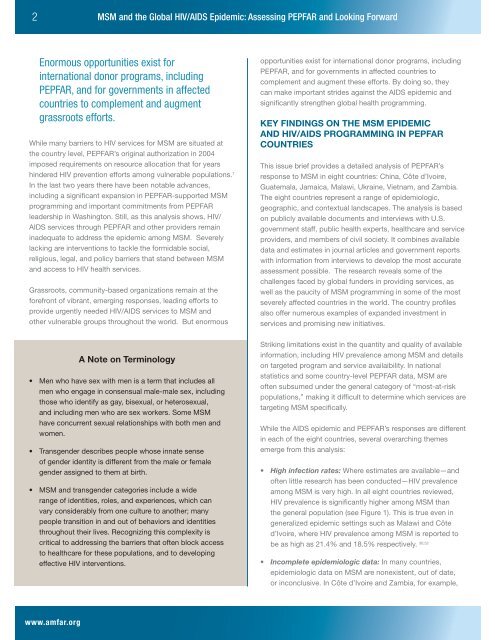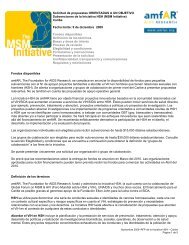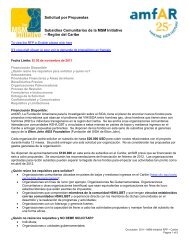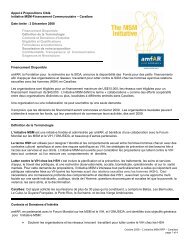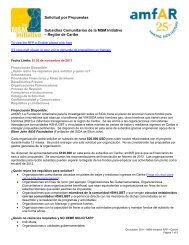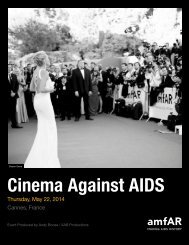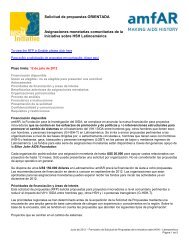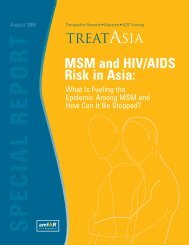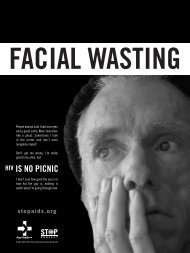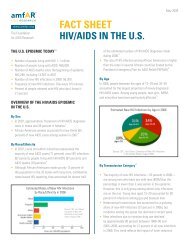Issue Brief: MSM and the Global HIV/AIDS Epidemic - amfAR
Issue Brief: MSM and the Global HIV/AIDS Epidemic - amfAR
Issue Brief: MSM and the Global HIV/AIDS Epidemic - amfAR
Create successful ePaper yourself
Turn your PDF publications into a flip-book with our unique Google optimized e-Paper software.
2<br />
<strong>MSM</strong> <strong>and</strong> <strong>the</strong> <strong>Global</strong> <strong>HIV</strong>/<strong>AIDS</strong> <strong>Epidemic</strong>: Assessing PEPFAR <strong>and</strong> Looking Forward<br />
Enormous opportunities exist for<br />
international donor programs, including<br />
PEPFAR, <strong>and</strong> for governments in affected<br />
countries to complement <strong>and</strong> augment<br />
grassroots efforts.<br />
While many barriers to <strong>HIV</strong> services for <strong>MSM</strong> are situated at<br />
<strong>the</strong> country level, PEPFAR’s original authorization in 2004<br />
imposed requirements on resource allocation that for years<br />
hindered <strong>HIV</strong> prevention efforts among vulnerable populations. 7<br />
In <strong>the</strong> last two years <strong>the</strong>re have been notable advances,<br />
including a significant expansion in PEPFAR-supported <strong>MSM</strong><br />
programming <strong>and</strong> important commitments from PEPFAR<br />
leadership in Washington. Still, as this analysis shows, <strong>HIV</strong>/<br />
<strong>AIDS</strong> services through PEPFAR <strong>and</strong> o<strong>the</strong>r providers remain<br />
inadequate to address <strong>the</strong> epidemic among <strong>MSM</strong>. Severely<br />
lacking are interventions to tackle <strong>the</strong> formidable social,<br />
religious, legal, <strong>and</strong> policy barriers that st<strong>and</strong> between <strong>MSM</strong><br />
<strong>and</strong> access to <strong>HIV</strong> health services.<br />
Grassroots, community-based organizations remain at <strong>the</strong><br />
forefront of vibrant, emerging responses, leading efforts to<br />
provide urgently needed <strong>HIV</strong>/<strong>AIDS</strong> services to <strong>MSM</strong> <strong>and</strong><br />
o<strong>the</strong>r vulnerable groups throughout <strong>the</strong> world. But enormous<br />
opportunities exist for international donor programs, including<br />
PEPFAR, <strong>and</strong> for governments in affected countries to<br />
complement <strong>and</strong> augment <strong>the</strong>se efforts. By doing so, <strong>the</strong>y<br />
can make important strides against <strong>the</strong> <strong>AIDS</strong> epidemic <strong>and</strong><br />
significantly streng<strong>the</strong>n global health programming.<br />
KEY FINDINGS ON THE <strong>MSM</strong> EPIDEMIC<br />
AND <strong>HIV</strong>/<strong>AIDS</strong> PROGRAMMING IN PEPFAR<br />
COUNTRIES<br />
This issue brief provides a detailed analysis of PEPFAR’s<br />
response to <strong>MSM</strong> in eight countries: China, Côte d’Ivoire,<br />
Guatemala, Jamaica, Malawi, Ukraine, Vietnam, <strong>and</strong> Zambia.<br />
The eight countries represent a range of epidemiologic,<br />
geographic, <strong>and</strong> contextual l<strong>and</strong>scapes. The analysis is based<br />
on publicly available documents <strong>and</strong> interviews with U.S.<br />
government staff, public health experts, healthcare <strong>and</strong> service<br />
providers, <strong>and</strong> members of civil society. It combines available<br />
data <strong>and</strong> estimates in journal articles <strong>and</strong> government reports<br />
with information from interviews to develop <strong>the</strong> most accurate<br />
assessment possible. The research reveals some of <strong>the</strong><br />
challenges faced by global funders in providing services, as<br />
well as <strong>the</strong> paucity of <strong>MSM</strong> programming in some of <strong>the</strong> most<br />
severely affected countries in <strong>the</strong> world. The country profiles<br />
also offer numerous examples of exp<strong>and</strong>ed investment in<br />
services <strong>and</strong> promising new initiatives.<br />
A Note on Terminology<br />
• Men who have sex with men is a term that includes all<br />
men who engage in consensual male-male sex, including<br />
those who identify as gay, bisexual, or heterosexual,<br />
<strong>and</strong> including men who are sex workers. Some <strong>MSM</strong><br />
have concurrent sexual relationships with both men <strong>and</strong><br />
women.<br />
• Transgender describes people whose innate sense<br />
of gender identity is different from <strong>the</strong> male or female<br />
gender assigned to <strong>the</strong>m at birth.<br />
• <strong>MSM</strong> <strong>and</strong> transgender categories include a wide<br />
range of identities, roles, <strong>and</strong> experiences, which can<br />
vary considerably from one culture to ano<strong>the</strong>r; many<br />
people transition in <strong>and</strong> out of behaviors <strong>and</strong> identities<br />
throughout <strong>the</strong>ir lives. Recognizing this complexity is<br />
critical to addressing <strong>the</strong> barriers that often block access<br />
to healthcare for <strong>the</strong>se populations, <strong>and</strong> to developing<br />
effective <strong>HIV</strong> interventions.<br />
Striking limitations exist in <strong>the</strong> quantity <strong>and</strong> quality of available<br />
information, including <strong>HIV</strong> prevalence among <strong>MSM</strong> <strong>and</strong> details<br />
on targeted program <strong>and</strong> service availaibility. In national<br />
statistics <strong>and</strong> some country-level PEPFAR data, <strong>MSM</strong> are<br />
often subsumed under <strong>the</strong> general category of “most-at-risk<br />
populations,” making it difficult to determine which services are<br />
targeting <strong>MSM</strong> specifically.<br />
While <strong>the</strong> <strong>AIDS</strong> epidemic <strong>and</strong> PEPFAR’s responses are different<br />
in each of <strong>the</strong> eight countries, several overarching <strong>the</strong>mes<br />
emerge from this analysis:<br />
• High infection rates: Where estimates are available—<strong>and</strong><br />
often little research has been conducted—<strong>HIV</strong> prevalence<br />
among <strong>MSM</strong> is very high. In all eight countries reviewed,<br />
<strong>HIV</strong> prevalence is significantly higher among <strong>MSM</strong> than<br />
<strong>the</strong> general population (see Figure 1). This is true even in<br />
generalized epidemic settings such as Malawi <strong>and</strong> Côte<br />
d’Ivoire, where <strong>HIV</strong> prevalence among <strong>MSM</strong> is reported to<br />
be as high as 21.4% <strong>and</strong> 18.5% respectively. 30,52<br />
• Incomplete epidemiologic data: In many countries,<br />
epidemiologic data on <strong>MSM</strong> are nonexistent, out of date,<br />
or inconclusive. In Côte d’Ivoire <strong>and</strong> Zambia, for example,<br />
www.amfar.org


